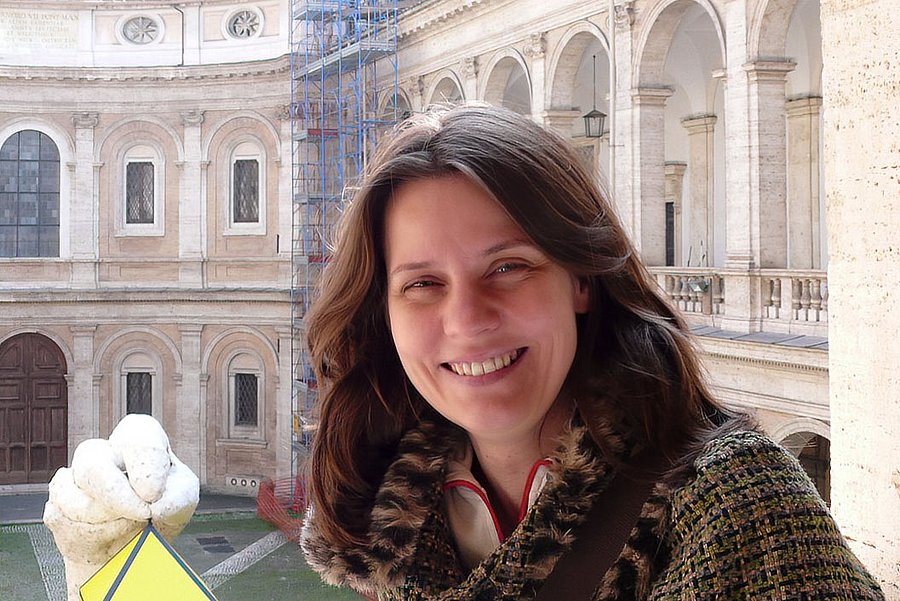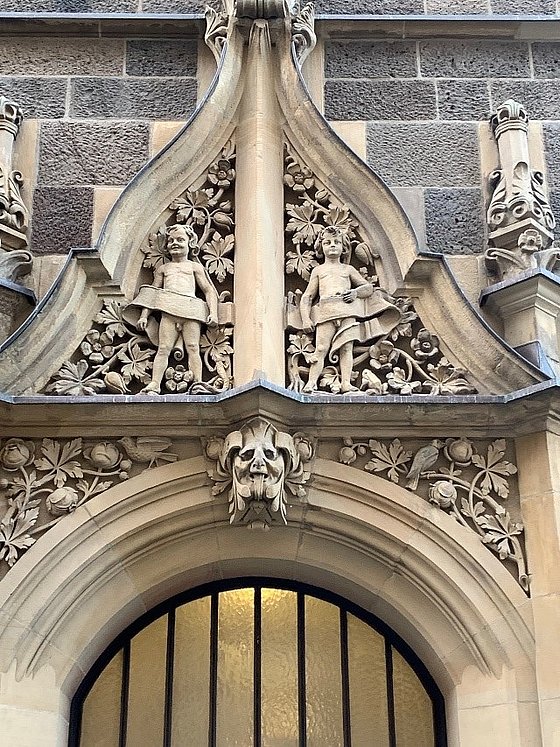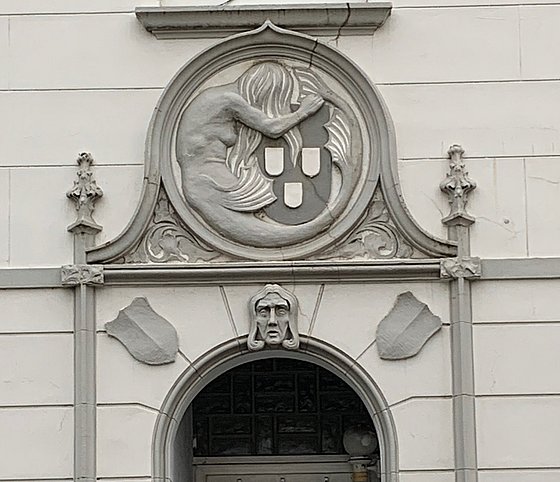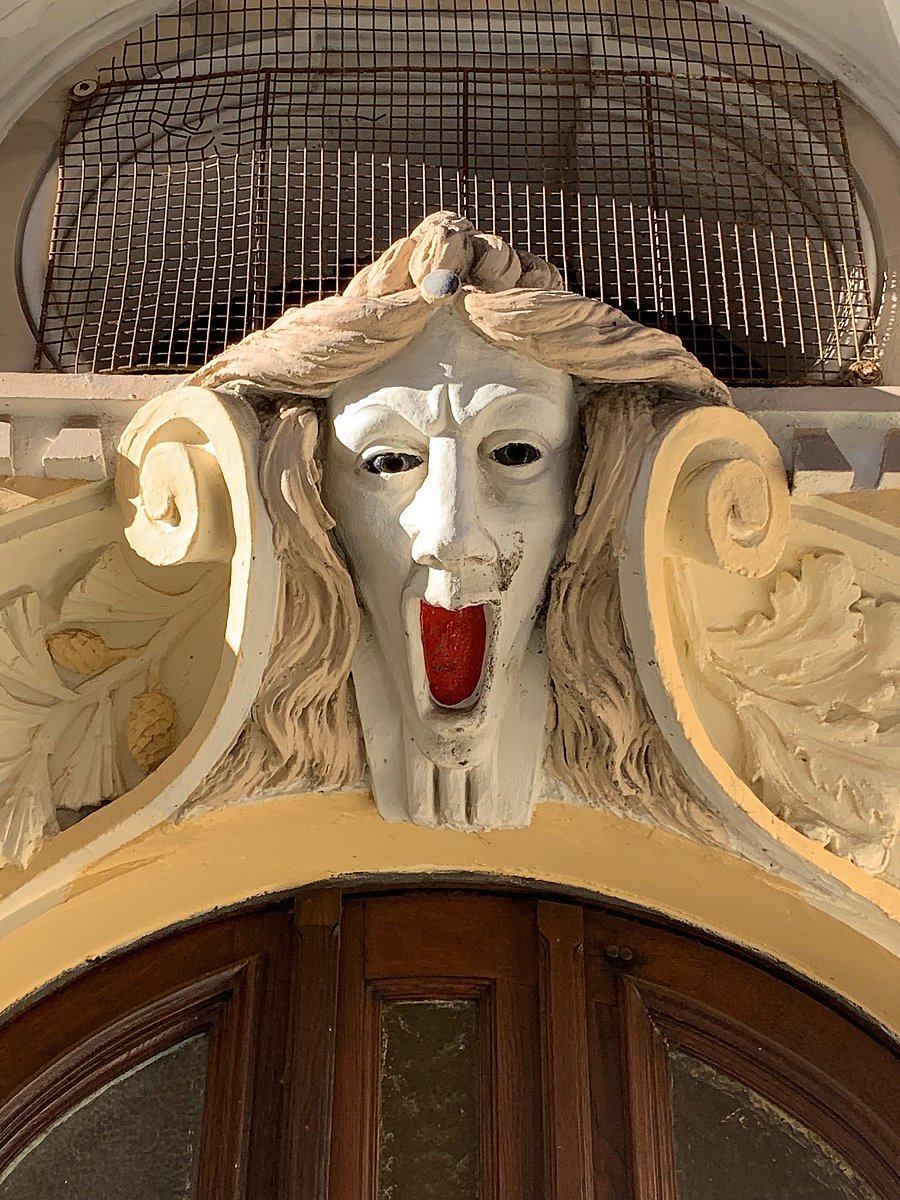
Facade decoration - envious heads in Wuppertal
Dr. Doris Lehmann / History of Art
Photo: Private
Facade decoration: The long tradition of masks and grimaces
Art historian Dr. Doris Lehmann on envious heads and mascarons that also exist in Wuppertal Ms. Lehmann, from many houses, gables and walls here in Wuppertal, grimaces stare at us, which are called envious heads. How long have these figures been around?
Lehmann: Heads, masks and grimaces have a long tradition as facade decorations; depending on how you read it, their roots go back to antiquity or the Middle Ages. What many today call "envious heads" can be vividly traced back to the late Middle Ages with preserved examples made of wood or stone. However, the term "envious head", which is often referred back to Alexander Cosmar, is probably not that old. In his publication "Sagen und Miscellen aus Berlin's Vorzeit" (legends and miscellanies from Berlin's prehistoric times) in 1831, Cosmar used the word as a well-known one. Cosmar himself, however, was not referring to a particular type of sculpture, but specifically to a bust which he dated to the 18th century and which at that time still adorned the facade of the Berlin house at Heiliggeist Str. 38.

Side entrance City Hall Elberfeld
Photo: UniService Transfer
What is their significance?
Lehmann: The significance of the heads on the facades is not certain beyond their function as architectural decoration. During the Romantic period, Cosmar related the facade decoration now kept by the Stadtmuseum Berlin to an anecdote about envious competitors. Since he was not an art historian, he did not realize that the bust he saw was correctly called "envy" by his fellow citizens because, in accordance with the pictorial tradition established since the Renaissance, it shows their personification: an emaciated and ugly old woman with snake hair. The folkloric extension of the name of this single piece to a terminology that is also applied to much older examples of other types of representations represents a problematic generalization in my view, which to my knowledge cannot be based on earlier writings. The naming and interpretation of façade decoration as envy heads ascribes a function to the artifacts that is more or less speculatively assigned to defensive symbolism. If the derivation from "envy" is explicitly avoided in order to derive instead from the Old High German or Middle High German "nit" or "nid", then the etymological difference is emphasized: the context of the heads is thus detached from a specific context and placed in more general contexts.
The origins probably go back to the Celts, i.e. to pre-Christian times. Did they already serve as a deterrent then?
Lehmann: That is possible, but it has not been proven. Superstitions and defensive spells have been deliberately poorly documented as secret knowledge.

Envy head on a house on Leimbacher St.
Photo: UniService Transfer
Envy heads come in a wide variety of designs. What are they, for example?
Lehmann: On half-timbered buildings, the ends of beams were designed as frontally aligned heads, other specimens are cut from stone. There are beardless faces as well as bearded ones, and there are other possible combinations. There are heads with eyes wide open and mouths open as if to scream, but also calm facial expressions with tongue stuck out strongly or a little. A representation can be supplemented by long animal-like ears, reminiscent of goats or donkeys, as another ingredient examples with jester's cap can be found.
Envy heads come rather from the belief in magic. In the Renaissance they were very popular under the name of mascaron (grimace face) as a purely ornamental work. Why in this epoch in particular?
Lehmann: During the Renaissance, there was a growing appreciation for fantasy and creativity. Masks or mascarons, which were firmly connected to architecture, could be given different roles and thus serve to bring life. The possible range with which viewers could be delighted ranged from witty to erudite, from beautiful to gruesome to grotesque.
One can also find depictions of prominent people. For example, the grimace head of Catherine Bellier (1614 - 1689) in the Hotel de Beauvais in Paris, a mistress of King Louis XIV, who lived there at the time. So could such depictions of a person also serve to honor that person?
Lehmann: As long as no historically secured portrait of Catherine Bellier is known, the naming of the head remains doubtful. I have no idea since when the facade ornament with the long hairstyle has been so named; I would be interested to know if there is any evidence from the time before the French Revolution. As a tour guide, I would definitely use the potential associated with the anecdote to arouse the curiosity of my listeners. As a scientist, however, I am rather skeptical about the evidence and the question of an "appreciation". I rather suspect that the "identification" is supposed to prove that the mistress has just not fulfilled an ideal of beauty, because the head is cross-eyed. Which goal could have been served by such a questionable context? Here I think caution is appropriate, because a squinting representation does not necessarily aim at the appreciation of the allegedly depicted person, even if it can serve it.

Eerie envy head on the street Zur Scheuren
Photo: UniService Transfer
Envy heads or also called gaff heads are a kind of facade decoration that really looks at the viewer. An eerie example can be found in the Wuppertal street Zur Scheuren. Was this actually already mass-produced or always just a special commissioned work?
Lehmann: To speak of "mass-produced goods" in connection with the construction of buildings that were cost-intensive for the individual clients is a subject in itself. In the area of façade decoration, it is a special feature that we can definitely prove from Historicism, because in the second half of the 19th century it was possible to use duplications by means of casting processes for the production of decorative building elements. This can be easily observed on the Vienna Ringstrasse. However, I would not speak of such "mass production" in this case.
Even today, envious heads and mascarons can still be found. The fashion designer Gianni Versace, for example, created a timeless design with his "Medusa" series, which can also be purchased in the form of vases or stucco reliefs. Is that still the fascination of the uncanny?
Lehmann: The Versace logo plays with the attention-grabbing Gorgoneion, as the isolated Medusa head has been called since antiquity. According to myth, the sight of it petrifies anyone who looks at it with terror. For the luxury label, the designer did not opt for an archaic version with eyes wide open and tongue sticking out, which was called an apotropaion (An apotropaion was placed in antiquity to protect people, animals, buildings, etc. and was supposed to ward off the evil effects of sorcery. Editor's note) is interpreted. Instead, he used a more beautiful and moderate model, as we can admire in the Hellenistic marble high relief of the Medusa Rondanini in the Munich Glyptothek. Whether an antique of this type was unearthed during the designer's childhood in Calabria, as the company legend claims, I unfortunately do not know. But the well-preserved antique, which had already been appreciated by Goethe, has enough relatives to have inspired Gianni Versace to the idea that others should turn green with envy at the sight of his fashion. This has little to do with the original "fascination" by enchanting looks, because we now know that looks cannot physically kill. So anyone who sees a Versace T-shirt or eats from a plate with the appropriate decoration need have no fear.
Uwe Blass
Dr. Doris H. Lehmann is a trained photographer and studied art history, classical archaeology, provincial Roman archaeology and Latin philology at the University of Cologne, where she received her doctorate in 2005. In 2018, she habilitated at the Rheinische Friedrich-Wilhelms-Universität Bonn with a thesis on the strategies of dispute of visual artists in the modern era and has been a private lecturer since then. Since October 2018, she has been teaching art history as a research assistant at Bergische Universität.
